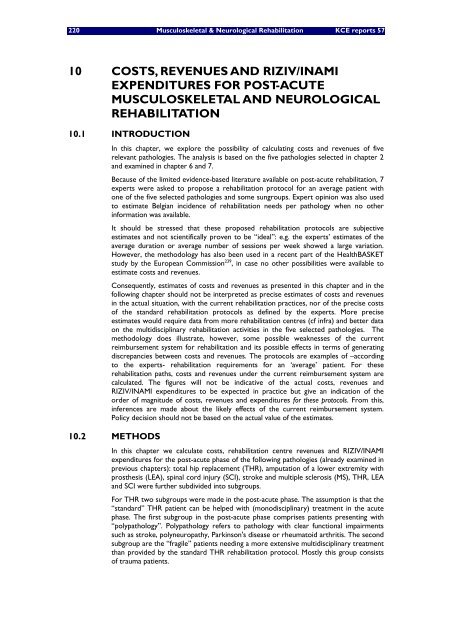The report is available in English with a French summary - KCE
The report is available in English with a French summary - KCE
The report is available in English with a French summary - KCE
Create successful ePaper yourself
Turn your PDF publications into a flip-book with our unique Google optimized e-Paper software.
220 Musculoskeletal & Neurological Rehabilitation <strong>KCE</strong> <strong>report</strong>s 57<br />
10 COSTS, REVENUES AND RIZIV/INAMI<br />
EXPENDITURES FOR POST-ACUTE<br />
MUSCULOSKELETAL AND NEUROLOGICAL<br />
REHABILITATION<br />
10.1 INTRODUCTION<br />
In th<strong>is</strong> chapter, we explore the possibility of calculat<strong>in</strong>g costs and revenues of five<br />
relevant pathologies. <strong>The</strong> analys<strong>is</strong> <strong>is</strong> based on the five pathologies selected <strong>in</strong> chapter 2<br />
and exam<strong>in</strong>ed <strong>in</strong> chapter 6 and 7.<br />
Because of the limited evidence-based literature <strong>available</strong> on post-acute rehabilitation, 7<br />
experts were asked to propose a rehabilitation protocol for an average patient <strong>with</strong><br />
one of the five selected pathologies and some sungroups. Expert op<strong>in</strong>ion was also used<br />
to estimate Belgian <strong>in</strong>cidence of rehabilitation needs per pathology when no other<br />
<strong>in</strong>formation was <strong>available</strong>.<br />
It should be stressed that these proposed rehabilitation protocols are subjective<br />
estimates and not scientifically proven to be “ideal”: e.g. the experts’ estimates of the<br />
average duration or average number of sessions per week showed a large variation.<br />
However, the methodology has also been used <strong>in</strong> a recent part of the HealthBASKET<br />
study by the European Comm<strong>is</strong>sion 239 , <strong>in</strong> case no other possibilities were <strong>available</strong> to<br />
estimate costs and revenues.<br />
Consequently, estimates of costs and revenues as presented <strong>in</strong> th<strong>is</strong> chapter and <strong>in</strong> the<br />
follow<strong>in</strong>g chapter should not be <strong>in</strong>terpreted as prec<strong>is</strong>e estimates of costs and revenues<br />
<strong>in</strong> the actual situation, <strong>with</strong> the current rehabilitation practices, nor of the prec<strong>is</strong>e costs<br />
of the standard rehabilitation protocols as def<strong>in</strong>ed by the experts. More prec<strong>is</strong>e<br />
estimates would require data from more rehabilitation centres (cf <strong>in</strong>fra) and better data<br />
on the multid<strong>is</strong>cipl<strong>in</strong>ary rehabilitation activities <strong>in</strong> the five selected pathologies. <strong>The</strong><br />
methodology does illustrate, however, some possible weaknesses of the current<br />
reimbursement system for rehabilitation and its possible effects <strong>in</strong> terms of generat<strong>in</strong>g<br />
d<strong>is</strong>crepancies between costs and revenues. <strong>The</strong> protocols are examples of –accord<strong>in</strong>g<br />
to the experts- rehabilitation requirements for an ‘average’ patient. For these<br />
rehabilitation paths, costs and revenues under the current reimbursement system are<br />
calculated. <strong>The</strong> figures will not be <strong>in</strong>dicative of the actual costs, revenues and<br />
RIZIV/INAMI expenditures to be expected <strong>in</strong> practice but give an <strong>in</strong>dication of the<br />
order of magnitude of costs, revenues and expenditures for these protocols. From th<strong>is</strong>,<br />
<strong>in</strong>ferences are made about the likely effects of the current reimbursement system.<br />
Policy dec<strong>is</strong>ion should not be based on the actual value of the estimates.<br />
10.2 METHODS<br />
In th<strong>is</strong> chapter we calculate costs, rehabilitation centre revenues and RIZIV/INAMI<br />
expenditures for the post-acute phase of the follow<strong>in</strong>g pathologies (already exam<strong>in</strong>ed <strong>in</strong><br />
previous chapters): total hip replacement (THR), amputation of a lower extremity <strong>with</strong><br />
prosthes<strong>is</strong> (LEA), sp<strong>in</strong>al cord <strong>in</strong>jury (SCI), stroke and multiple scleros<strong>is</strong> (MS), THR, LEA<br />
and SCI were further subdivided <strong>in</strong>to subgroups.<br />
For THR two subgroups were made <strong>in</strong> the post-acute phase. <strong>The</strong> assumption <strong>is</strong> that the<br />
“standard” THR patient can be helped <strong>with</strong> (monod<strong>is</strong>cipl<strong>in</strong>ary) treatment <strong>in</strong> the acute<br />
phase. <strong>The</strong> first subgroup <strong>in</strong> the post-acute phase compr<strong>is</strong>es patients present<strong>in</strong>g <strong>with</strong><br />
“polypathology”. Polypathology refers to pathology <strong>with</strong> clear functional impairments<br />
such as stroke, polyneuropathy, Park<strong>in</strong>son's d<strong>is</strong>ease or rheumatoid arthrit<strong>is</strong>. <strong>The</strong> second<br />
subgroup are the “fragile” patients need<strong>in</strong>g a more extensive multid<strong>is</strong>cipl<strong>in</strong>ary treatment<br />
than provided by the standard THR rehabilitation protocol. Mostly th<strong>is</strong> group cons<strong>is</strong>ts<br />
of trauma patients.

















